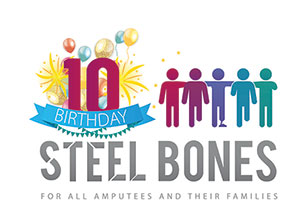Prosthetics and Mobility – FAQ’S
Disclaimer:
Information shared about prosthetics is for general awareness only. Every amputee’s needs, circumstances, and goals are unique, and available options can vary widely between limb centres. Your prosthetist and physiotherapist are the key professionals who can advise what is appropriate for you. Always seek their guidance before making decisions about your prosthetic care, adjustments, or rehabilitation.

When will I be able to get a prosthetic limb?
This depends on your individual recovery. Typically, once your wound has healed and your residual limb has settled in size, your clinical team will refer you for an assessment. The MDT (multi-disciplinary team) decides on limb provision and future limb provision based on mobility grade, vocation and daily life.
Sometimes a physiotherapist will let you try walking on a pneumatic pylon or inflatable air limb, which is inflated around your limb prior to getting a prosthetic. This will be for use in the hospital only but it’s a great feeling to be back on your feet.
Who decides what type of prosthetic I get?
A prosthetist at your local Limb Centre will assess your needs, lifestyle, and goals. They’ll work with you to choose a prosthetic that’s right for you. Sometimes a basic limb is provided as a first prosthetic to enable people to start progressing quickly and upgrades can be issued as your use of the prosthetic improves.
Is it painful to use a prosthetic?
Some discomfort is normal at first, as your body adjusts. However, a well-fitted prosthetic shouldn’t cause ongoing pain. If you’re struggling, we can help you speak to your Limb Centre or arrange peer support with someone who’s been there.
Lower Residual limbs are not naturally designed to accommodate weight bearing. The first three months are difficult for primary folk-blister, rubs and volume changes are common. Normally settles after 8 months. The rule is if you have a breakdown, stop wearing the limb and consult your service or GP. Your service is prepared to see you as many times as required, as stated.
What if I decide not to use a prosthetic limb?
That’s completely your choice. Not everyone uses a prosthetic — some people use wheelchairs or mobility aids instead. What matters most is finding what helps you move with comfort and confidence.
Can Steel Bones help me with mobility issues beyond prosthetics?
Yes! We can support you in getting the right aids, equipment, and home adaptations. We also run events and peer groups where you can learn tips and tricks from others living with limb loss.
Can I get more than one prosthetic - for different activities?
NHS guidelines state one limb provided per patient. We need a good clear clinical reason for a second limb. This will help establish good grounds and justification for the request when we apply.
How often will I need to visit a prosthetic centre?
There is likely to be several visits when you are first ready for your first prosthetic limb. The process varies from person to person, but a cast is made of your residual limb, which is used to make a custom socket to attach you to the prosthetic limb. There will then be the other parts added and adjusted to fit your particular needs.
It is quite common to need several adjustments and new sockets as your limb swelling reduces and you get used to your prosthetic. Over time, you will need to visit far less, mostly due to wear and tear on your prosthetic limb.
What happens if my prosthetic doesn't fit well or causes issues?
Let your Limb Centre know as soon as possible — don’t suffer in silence. They can adjust or remake the socket to improve comfort. Steel Bones can also help you advocate for timely adjustments if needed. Skin is a living organ. Please doff your limb 2-3 times a day and dry with a flannel or towel. This will allow the skin to breathe for 10-15 minutes.
Are there costs involved in getting a prosthetic?
If you are treated on the NHS, your prosthetics are provided free of charge. However, private options are also available for those who wish to explore alternatives. We can help you understand both routes.
How long does it take to learn to walk again?
It varies from person to person. Physiotherapy and practice are key. With support, most people make steady progress over a few weeks or months. Steel Bones can connect you with peers who’ve walked this road before.

Will I be able to walk again?
Many amputees do walk again, either with a prosthetic or a mobility aid. It depends on your level of amputation, overall health, and rehabilitation. We’re here to help you explore all mobility options and celebrate each step forward.
Telephone
03333 606930
Address
Isleham Business Park, Hall Barn Road, Isleham
Cambs CB7 5QZ
hello@steelbone.co.uk
Register here to receive your
FREE Support Pack
If you need some urgent help or support,
please ring the team on 03333 606930
